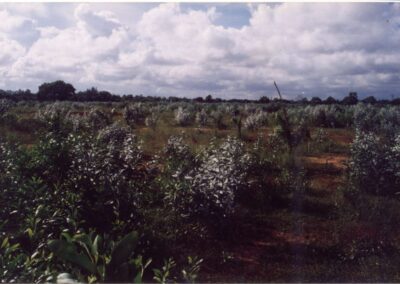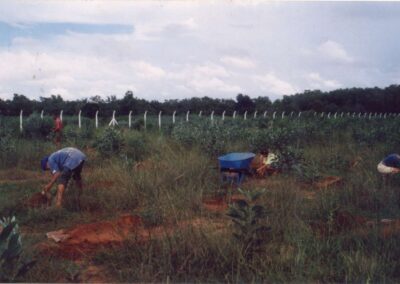The restoration of the Tropical Dry Evergreen Forest, within the township of Auroville has been an evolving process spread over the last 50 years carried out by numerous individuals who have been involved in the work. When the project started in 1968, the areas was a barren, eroded plateau. Many areas were devoid of topsoil, as the monsoon rains had washed it off, and created a wasteland crisscrossed with canyons. The first settlers planted a pioneer forest, a mix of species, in haphazard fashion without any real intention other than to create shade, arrest soil erosion and to create a habitable environment. Some native species were included in the mix, but it was the exotic species such as Acacia auriculiformis that dominated the forest areas by the mid-eighties.
However, by this time there was a growing interest in the local forests of the bioregion, small remnant temple groves and some areas of Reserve Forest. The exploration of these areas, and a more systematic approach to their study lead to the understanding that the native forest of the region was the Tropical Dry Evergreen Forest (TDEF). Concurrent with the studies, seed from these indigenous species were collected and grown in the nurseries. Over the next 20 years the process continued, and these species were planted out, both on new lands and as an understory in the previously established forest.
The TDEF is comprised of both evergreen and deciduous species, and so with the variety of niches present a mixed forest has established of over 250 native species of trees, shrubs, lianas and epiphytes. Presently there is a natural succession taking place as the exotic species from the original plantations are reaching the ends of their shorter lifecycles or succumbing to natural calamities such as cyclones. The underplanted native trees and shrubs are now emerging as the long term, permanent forest cover. The knowledge and skills assimilated during this long-term project are now being disseminated across India, as a variety of individuals involved in this work take up other afforestation projects.
Typical evergreen species that are now self-regenerating in the Auroville forests include Diospyros ebenum, Chionanthus zeylanica, Memecylon umbellatum, Drypetes sepiaria, Walsura trifoliata, Aglaia elaeagnoidea, Tricalysia sphaerocarpa, Dimorphocalyx glabellus and Psydrax dicoccos.





